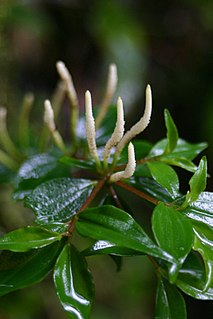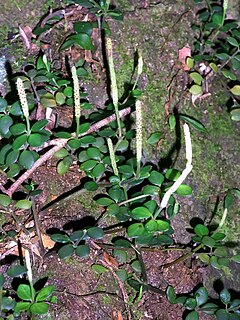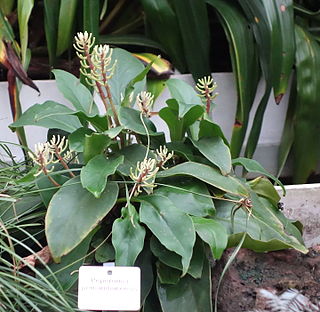
Peperomia is one of the two large genera of the family Piperaceae. Most of them are compact, small perennial epiphytes growing on rotten wood. More than 1500 species have been recorded, occurring in all tropical and subtropical regions of the world, though concentrated in Central America and northern South America. A limited number of species are found in Africa.

The Piperaceae, also known as the pepper family, are a large family of flowering plants. The group contains roughly 3,600 currently accepted species in 5 genera. The vast majority of peppers can be found within the two main genera: Piper and Peperomia.

The Hawaiian jungles are a tropical moist broadleaf forest ecoregion in the Hawaiian Islands. They cover an area of 6,700 km2 (2,600 sq mi) in the windward lowlands and montane regions of the islands. Coastal mesic forests are found at elevations from sea level to 300 m (980 ft). Mixed mesic forests occur at elevations of 750 to 1,250 m, while wet forests are found from 1,250 to 1,700 m. Moist bogs and shrublands exist on montane plateaus and depressions. For the 28 million years of existence of the Hawaiian Islands, they have been isolated from the rest of the world by vast stretches of the Pacific Ocean, and this isolation has resulted in the evolution of an incredible diversity of endemic species, including fungi, mosses, snails, birds, and other wildlife. In the lush, moist forests high in the mountains, trees are draped with vines, orchids, ferns, and mosses. This ecoregion includes one of the world's wettest places, the slopes of Mount Waiʻaleʻale, which average 373 in (9,500 mm) of rainfall per year.
Purslane is a common name for several plants with edible leaves and may refer to:
British NVC community MG11 is one of the mesotrophic grassland communities in the British National Vegetation Classification system. It is one of three types of mesotrophic grassland classified as grass-dominated inundation communities.
NVC community SD2 is one of two strandline community in the British National Vegetation Classification system.

Honckenya peploides, the sea sandwort (UK) or seaside sandplant (Canada), is the only species in the genus Honckenya of the flowering plant family Caryophyllaceae. Other common names include sea chickweed, sea pimpernal, sea-beach sandwort, and sea purslane. The scientific name is often spelled "Honkenya", and is named after the German botanist Gerhard August Honckeny. This plant has a circumboreal distribution.
Peperomia disjunctiflora is a species of plant in the family Piperaceae. It is endemic to Ecuador.
Peperomia involucrata is a species of plant in the family Piperaceae. It is endemic to Ecuador.
Peperomia litana is a species of plant in the family Piperaceae. It is endemic to Ecuador.
Peperomia pachystachya is a species of plant in the family Piperaceae. It is endemic to Ecuador.
Peperomia petraea is a species of plant in the family Piperaceae. It is endemic to Ecuador.
Peperomia wibomii is a species of plant in the family Piperaceae. It is endemic to Ecuador.

Peperomia pellucida is an annual, shallow-rooted herb, usually growing to a height of about 15 to 45 cm, it is characterized by succulent stems, shiny, heart-shaped, fleshy leaves and tiny, dot-like seeds attached to several fruiting spikes. It has a mustard-like odor when crushed. The family Piperaceae comprises about a dozen genera and around 3000 species. The genus Peperomia represents nearly half of the Piperaceae with the genus Piper making the rest.

Ludwigia peploides is a species of flowering plant in the evening primrose family known by the common names floating primrose-willow and creeping water primrose. It is native to many parts of the Americas, but it can be found on many continents and spreads easily to become naturalized. It is well known as a troublesome aquatic noxious weed that invades water ecosystems and can clog waterways. This is perennial herb which grows in moist to wet to flooded areas. The stem can creep over 2 meters long, sometimes branching. It spreads to form mats on the mud, or floats ascending in the water. The leaves are several centimeters long and are borne in alternately arranged clusters along the stem. The flower has 5 to 6 lance-shaped sepals beneath a corolla of 5 or 6 bright yellow petals up to 2.4 centimeters long. The fruit is a hard, cylindrical capsule.
Foliata, a Latin word meaning leafy, may refer to:

Peperomia wheeleri is a rare species of flowering plant in the pepper family known by the common name Wheeler's peperomia. It is endemic to Puerto Rico, where it is known only from the island of Culebra. It has been become rare because of deforestation and grazing by livestock. It is a federally listed endangered species of the United States.

Peperomia tetraphylla, known as the acorn peperomia or four-leaved peperomia, is a small plant in the pepper family that grows in Australia, Asia, Africa, New Zealand, Lord Howe Island, and other islands in the Pacific Ocean. In New South Wales, it is often seen as an epiphyte or growing on rocks in rainforests. Tiny flowers form on a spike, at the end of the branchlets. The specific epithet tetraphylla is from the Ancient Greek language, meaning "four leaves", though the species may also have whorls of 3.

Peperomia pernambucensis is a species of plant in the family Piperaceae.









